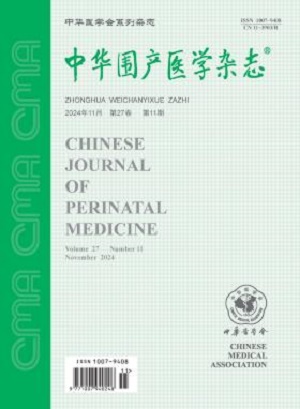早期新生儿基本护理对阴道出生早产儿脐炎的影响
Q4 Medicine
引用次数: 0
摘要
目的探讨新生儿早期基本护理(EENC)对正常分娩后早产儿脐炎发生的影响。方法回顾性收集2017年1月至2017年12月宁夏医科大学总医院收治的184例早产儿为EENC组。同期,在银川市妇幼保健院出生的161名早产儿被纳入对照组。EENC组的早产儿根据“新生儿早期基本护理”的临床实践指南进行管理,而对照组的早产儿在出生后接受常规护理。采用独立样本t检验和卡方检验比较两组患者的脐炎发生率。采用单因素分析法和多因素logistic回归分析法对脐炎的影响因素进行分析。结果轻度脐炎的发生率较低[5.4%(10/184)vs 11.8%(19/161),χ2=4.520,P<0.05,EENC组脐带残端分离和干燥时间均早于对照组[(5.5±1.5)vs(8.2±1.2)d,t=4.169;(2.6±1.4)vs(3.2±1.4)d,t=4.513;均P<0.05],早期脐带夹闭(OR=3.615,95%CI:1.372-9.381,P=0.001)和脐带残端包扎(OR=1.921,95%CI:1.257-11.893,P=0.035)是早产儿脐炎的独立危险因素。结论基于EENC的脐带治疗可以避免早产后脐炎的危险因素,从而降低脐炎的发生率。关键词:婴儿、早产;脐;炎症;脐带;缩窄;新生儿护理本文章由计算机程序翻译,如有差异,请以英文原文为准。
Effect of early essential newborn care on omphalitis in vaginally born preterm infants
Objective
To explore the influence of early essential newborn care(EENC) on the development of omphalitis in preterm infants following normal delivery.
Methods
A total of 184 preterm infants, admitted to General Hospital of Ningxia Medical University from January 2017 to December 2017, were retrospectively collected as EENC group. During the same period, 161 preterm infants who were born in Yinchuan Maternal and Child Health Hospital were included in the control group. Preterm infants in EENC group were managed based on the clinical practice guideline of "Early Essential Newborn Care", while those in the control group underwent routine care after birth. The incidence of omphalitis between the two groups were compared using independent-samples t test and Chi-square test. Influencing factors of omphalitis were analyzed using univariate analysis and multivariate logistic regression analysis.
Results
The incidence of mild omphalitis was lower [5.4% (10/184) vs 11.8% (19/161), χ2=4.520, P<0.05], and the separation and drying up time of cord stump were both earlier in the EENC group than those in the control group [(5.5±1.5) vs (8.2±1.2) d, t=4.169; (2.6±1.4) vs (3.2±1.4) d, t=4.513; both P<0.05]. Logistic regression analysis showed that gestational age≤34 weeks (OR=1.885, 95%CI: 1.109-6.757, P=0.032), early umbilical cord clamping (OR=3.615, 95%CI: 1.372-9.381, P=0.001) and bandaging of the umbilical stump (OR=1.921, 95%CI: 1.257-11.893, P=0.035) were independent risk factors of omphalitis in preterm infants.
Conclusions
Umbilical cord treatment based on EENC could reduce the incidence of omphalitis by avoiding its risk factors in preterm infants following normal delivery.
Key words:
Infant, premature; Umbilicus; Inflammation; Umbilical cord; Constriction; Neonatal nursing
求助全文
通过发布文献求助,成功后即可免费获取论文全文。
去求助
来源期刊

中华围产医学杂志
Medicine-Obstetrics and Gynecology
CiteScore
0.70
自引率
0.00%
发文量
4446
期刊介绍:
Chinese Journal of Perinatal Medicine was founded in May 1998. It is one of the journals of the Chinese Medical Association, which is supervised by the China Association for Science and Technology, sponsored by the Chinese Medical Association, and hosted by Peking University First Hospital. Perinatal medicine is a new discipline jointly studied by obstetrics and neonatology. The purpose of this journal is to "prenatal and postnatal care, improve the quality of the newborn population, and ensure the safety and health of mothers and infants". It reflects the new theories, new technologies, and new progress in perinatal medicine in related disciplines such as basic, clinical and preventive medicine, genetics, and sociology. It aims to provide a window and platform for academic exchanges, information transmission, and understanding of the development trends of domestic and foreign perinatal medicine for the majority of perinatal medicine workers in my country.
 求助内容:
求助内容: 应助结果提醒方式:
应助结果提醒方式:


